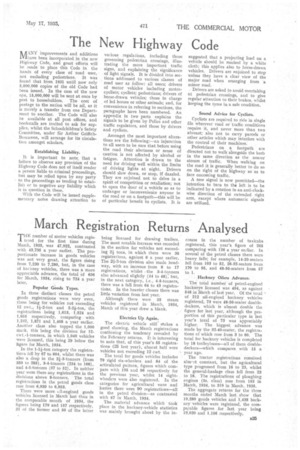The New Highway Code
Page 35

If you've noticed an error in this article please click here to report it so we can fix it.
uf ANY improvements and additions 1V1have been incorporated in the new Highway Code, and great efforts will be made to place this Code in the hands of every class of road user, not excluding pedestrians. It was found that from 1931 until now only 5,000,000 copies of the old Code had been issued. In the case of the new ope, 15,000,000 will be sent at once by post to householders. The cost of postage to the nation will be nil, as it is merely a transfer from one Department to another. The Code will also be available at all post offices, and bookstalls are invited to ask for supplies, whilst the Schoolchildren's Safety Committee, under Sir Arthur GriffithBoscawen, will arrange for its circ.ulaton amongst scholars.
Establishing Liability.
It is important to note; that a failure to observe any provision of the Highway Code does not of itself render a person liable to criminal proceedings, but may be relied upon by any party to the proceedings as tending to establish or to negative any liability which is in question in these.
With the Code will be issued supplementary notes drawing attention to various regulations, including those governing pedestrian crossings, illustrating the more important traffic signs, and explaining the significance of light signals. It is divided into sections addressed to various classes of road user as follow: all users; drivers of motor vehicles including motorcyclists; cyclists; pedestrians; drivers of • horse-drawn vehicles; those in charge of led horses or other animals; and, for convenience in referring to sections, the paragraphs have been numbered. An appendix in two parts explains the signals to be given by Police and other traffic regulators, and those by drivers and cyclists.
Amongst the most important alterations are the following:—an injunction to all users to be sure that before using the road their alertness or sense of caution is not affected by alcohol or fatigue. Attention is drawn to the need for driving well within the limits of driving lights at night. Drivers should slow down, or stop, if dazzled. They are enjoined not to drive in a spirit of competition or retaliation; not to open the door of a vehicle so as to endanger or inconvenience anyone in the road or on a footpath—this will be of particular benefit to cyclists. It is suggested that a projecting load on a vehicle should be marked by a white cloth; this applies also to horse-drawn vehicles. Drivers are enjoined to stop unless they have a clear view of the major road when emerging from a minor road.
Drivers are asked to avoid overtaking at pedestrian crossings, and to give regular attention to their brakes, whilst keeping the tyres in a safe condition.
• Sound Advice for Cyclists.
Cyclists are required to ride in single file wherever road or traffic conditions require it, and never more than two abreast; also not to carry parcels or other articles whieh may interfere with the control of their machines.
Pedestrians on a footpath are directed not to walk alongside the kerb in the same direction as the nearer stream of traffic. When walking on the road it is generally better to do so on the right of the highway so as to face oncoming traffic.
A new signal is now permitted—the intention to turn to the left is to be indicated by a rotation in an anti-clockwise direction of the extended right arm, except where automatic signals are utilized.






















































































